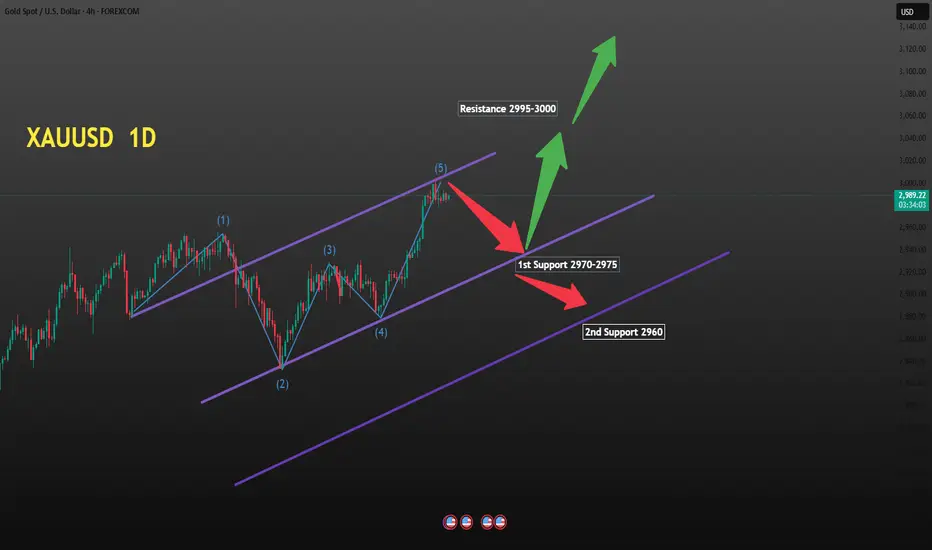May the world be at peace
If the U.S. war with the Houthis escalates further and the fighting broadens, the XAUUSD could top 3,200
The resurgence of war in the Middle East, specifically the conflict between the United States and the Houthi armed group, has the following impacts on gold:
Safe-haven demand drives up prices: Wars and geopolitical conflicts can trigger market panic. Investors are concerned about the turbulence in financial markets and the decline in the value of their assets, and they often turn to gold as a safe-haven asset. After Trump announced military actions against the Houthi armed group on March 15, the main contract of gold futures rose by more than 1.8% in a single day, pushing the price of gold to firmly stand at the historical high of 3,000 per ounce.
Changes in market sentiment lead to portfolio adjustments:
The uncertainty brought about by the war causes investors to reduce their holdings of risky assets such as stocks. Some large institutional investors and hedge funds will also adjust their investment portfolios by increasing their gold holdings to hedge against risks. This leads to an imbalance between supply and demand in the gold market and drives up prices.
Expectations of monetary policy adjustments:
If the conflict in the Middle East leads to a slowdown in global economic growth, central banks may adopt more accommodative monetary policies to stimulate the economy, such as interest rate cuts or quantitative easing. In such cases, the price of gold often rises because lower interest rates reduce the opportunity cost of holding gold. Currently, the market has increased expectations for the Federal Reserve to cut interest rates. If the Federal Reserve implements interest rate cuts in the future, it will further support the price of gold.
The trend of the US dollar has an indirect impact:
Generally, there is an inverse relationship between the US dollar and the price of gold. The war in the Middle East may make investors uneasy about the prospects of the US economy or prompt the Federal Reserve to adopt a more dovish monetary policy stance, leading to a weakening of the US dollar and, in turn, driving up the price of gold.
Rising inflation expectations:
Wars may lead to an increase in the prices of commodities such as crude oil, thereby triggering inflation expectations. As an effective hedge against inflation, the price of gold will be boosted when inflation expectations rise.
However, the specific trend of the gold price still needs to take into account other macroeconomic factors, policy changes, and the sentiment of market participants.
If the U.S. war with the Houthis escalates further and the fighting broadens, the XAUUSD could top 3,200
The resurgence of war in the Middle East, specifically the conflict between the United States and the Houthi armed group, has the following impacts on gold:
Safe-haven demand drives up prices: Wars and geopolitical conflicts can trigger market panic. Investors are concerned about the turbulence in financial markets and the decline in the value of their assets, and they often turn to gold as a safe-haven asset. After Trump announced military actions against the Houthi armed group on March 15, the main contract of gold futures rose by more than 1.8% in a single day, pushing the price of gold to firmly stand at the historical high of 3,000 per ounce.
Changes in market sentiment lead to portfolio adjustments:
The uncertainty brought about by the war causes investors to reduce their holdings of risky assets such as stocks. Some large institutional investors and hedge funds will also adjust their investment portfolios by increasing their gold holdings to hedge against risks. This leads to an imbalance between supply and demand in the gold market and drives up prices.
Expectations of monetary policy adjustments:
If the conflict in the Middle East leads to a slowdown in global economic growth, central banks may adopt more accommodative monetary policies to stimulate the economy, such as interest rate cuts or quantitative easing. In such cases, the price of gold often rises because lower interest rates reduce the opportunity cost of holding gold. Currently, the market has increased expectations for the Federal Reserve to cut interest rates. If the Federal Reserve implements interest rate cuts in the future, it will further support the price of gold.
The trend of the US dollar has an indirect impact:
Generally, there is an inverse relationship between the US dollar and the price of gold. The war in the Middle East may make investors uneasy about the prospects of the US economy or prompt the Federal Reserve to adopt a more dovish monetary policy stance, leading to a weakening of the US dollar and, in turn, driving up the price of gold.
Rising inflation expectations:
Wars may lead to an increase in the prices of commodities such as crude oil, thereby triggering inflation expectations. As an effective hedge against inflation, the price of gold will be boosted when inflation expectations rise.
However, the specific trend of the gold price still needs to take into account other macroeconomic factors, policy changes, and the sentiment of market participants.
Related publications
Disclaimer
The information and publications are not meant to be, and do not constitute, financial, investment, trading, or other types of advice or recommendations supplied or endorsed by TradingView. Read more in the Terms of Use.
Related publications
Disclaimer
The information and publications are not meant to be, and do not constitute, financial, investment, trading, or other types of advice or recommendations supplied or endorsed by TradingView. Read more in the Terms of Use.
